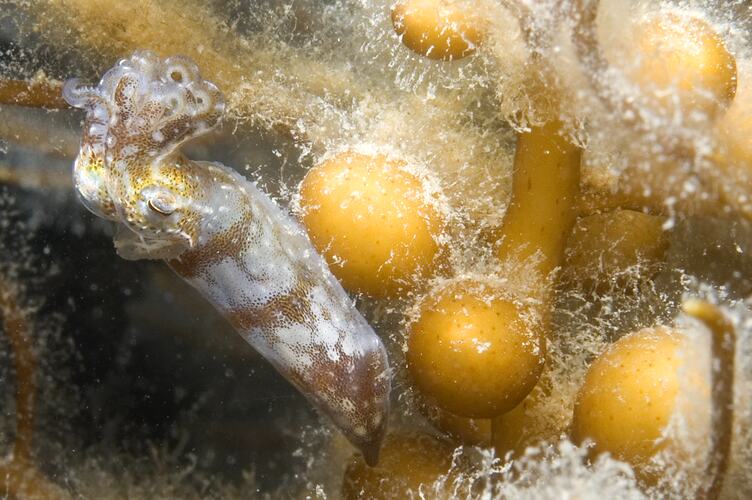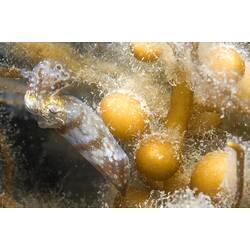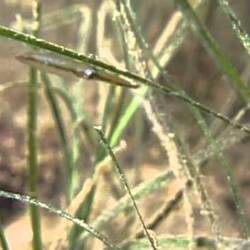General Description
Tiny cylindrical, free-swimming squid. Small pair of rounded fins on the rear tip of body. Large glandular patch on the rear two thirds of upper body. Colour varies from almost transparent, to iridescent green and yellow, to dark chocolate brown. Short white lines radiate from around the eyes. Female mantle length to 3 cm. Male mantle length to 16 mm, some maturing at less than 1 cm.
Biology
Pygmy squids are the smallest of all the cephalopods (the group containing squid, octopuses and cuttlefish). This squid is abundant in seagrass beds in bays and inlets, particularly eelgrass beds (Zostera and Heterozostera). It lives deep within the seagrass where it attaches to the underside of leaves using special glue glands situated on the top of its body. The glue gland allows the squid to maintain position without having to be buoyant or constantly swim. Pygmy squids are ambush predators that prey on small crustaceans and fish. They are able to push their mouth parts (beak and toothed tongue) deep into their prey. They are active both during the day and night. Females lay single round eggs in lines along the underside of seagrass leaves.
Distribution
Southern Australia.
Habitat
Seagrass beds in shallow bays and inlets to a depth of 20 m.
More Information
-
Animal Type
-
Animal SubType
-
Brief Id
10 arms and tentacles, very small, cylindrical body, rounded fins at end of body.
-
Colours
Brown, Green, White
-
Habitats
-
Diet
Carnivore
-
Diet Categories
Crustaceans
-
Hazards
Potential to bite, especially if handled. Venom status unknown.
-
Endemicity
-
Commercial
No
-
Conservation Statuses
CITES: Not listed, FFG Threatened List: Not listed, DSE Advisory List: Not listed, IUCN Red List: Data Deficient
-
Depths
Shallow (1-30 m)
-
Water Column Locations
On or near seafloor
-
Taxon Name
-
Scientific Author
Berry, 1921
-
Common Name
Southern Pygmy Squid
-
Phylum
-
Class
-
Subclass
-
Order
-
Family
-
Genus
-
Species Name
notoides




